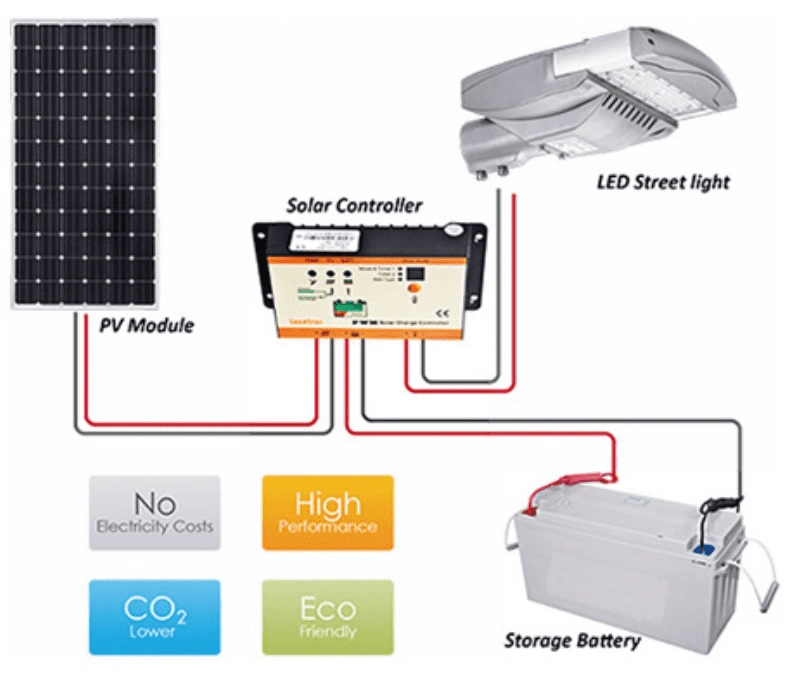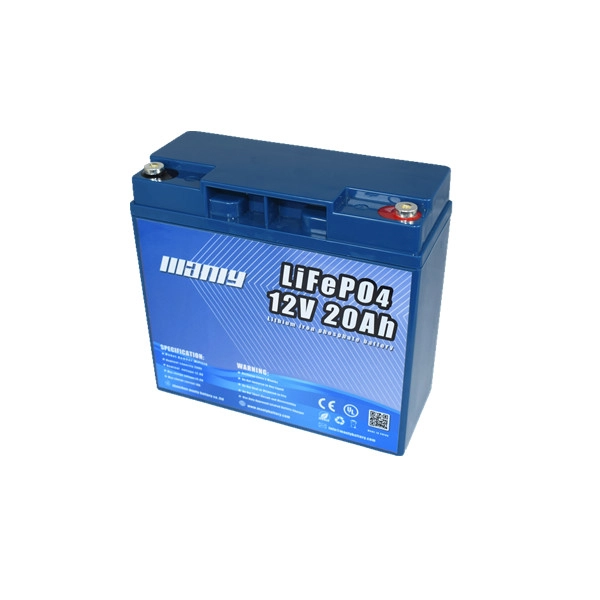Top Solar Street Light Battery Choices in 2023
Sommario
- Top Solar Street Light Battery Choices in 2023
- Perché il giusto tipo di batteria per lampione solare è così importante?
- How Energy Storage Batteries Power the Future: An Insight into Solar Street Light Battery Systems
- Scelta del tipo di batteria ottimale per l'illuminazione stradale solare
- Come posso calcolare la capacità e le dimensioni di cui ho bisogno?
- Qual è il tipo ideale di batteria per lampione solare?
- Pensieri finali
- Ulteriori informazioni sulla batteria
Stai cercando il tipo di batteria ideale per l'illuminazione stradale solare? Non è sempre facile individuare il tipo ottimale di batteria per l'illuminazione stradale solare e sono disponibili numerose opzioni. Fortunatamente, abbiamo delineato alcune delle cose fondamentali che devi sapere sulle opzioni della batteria per lampione solare per orientare la tua decisione.
Perché il giusto tipo di batteria per lampione solare è così importante?
Prima di andare oltre, dobbiamo innanzitutto chiarire perché scegliere il giusto tipo dibatteria per lampione solareè così importante.
Naturalmente, ci sono diversi fattori in gioco qui. In particolare è l'efficienza e l'affidabilità. Infatti, soprattutto durante i mesi invernali, c'è solo una quantità limitata di luce solare disponibile per caricare la batteria e immagazzinare energia, e con richieste di energia più elevate durante le notti invernali, l'importanza di avere una batteria in grado di essere all'altezza del lavoro è fondamentale.
In linea con ciò, è chiaro che la scelta della giusta batteria per lampione solare può avere un impatto significativo sulle prestazioni della luce.

How Energy Storage Batteries Power the Future: An Insight into Solar Street Light Battery Systems
Energy Storage Batteries primarily refer to batteries used for solar power systems, wind turbines, and other renewable energy storage purposes. One application of such a system is the Solar street light, which needs an Energy storage battery or, more specifically, a Solar street light battery, to store solar energy and provide it to the equipment. The performance of these batteries directly affects the storage capacity, safety, and longevity of power systems. So, what types of Energy storage batteries are out there, and what are their pros and cons? Let’s dive in.
Lo stoccaggio dell’energia può essere classificato in stoccaggio meccanico e stoccaggio chimico. Lo stoccaggio elettrochimico coinvolge batterie secondarie, dove gli elementi chimici fungono da mezzo di stoccaggio. Durante i processi di carica e scarica, questi elementi subiscono reazioni o modifiche chimiche. Alcuni tipi chiave includono batterie al piombo, batterie a flusso, batterie sodio-zolfo e batterie agli ioni di litio.
Batterie agli ioni di litio
- These batteries utilize lithium metal or lithium alloys as the anode material. Due to lithium’s reactive nature, handling and storing it requires specific conditions. With advancements in technology, they have become mainstream for applications including as a Solar street light battery.
- Pro: Lunga durata, alta densità di energia, leggero, adattabile.
- Contro: problemi di sicurezza, può essere esplosivo, costo elevato, limitazioni di utilizzo.
Batterie al litio ternarie
- Queste batterie utilizzano un materiale catodico ternario composto da ossido di manganese litio nichel cobalto. Il rapporto tra nichel, cobalto e manganese può essere regolato. Rispetto alle batterie al litio-cobalto, queste sono più sicure ma hanno un voltaggio inferiore.
- Pro: Alta densità di energia, dimensioni compatte.
- Contro: Scarsa stabilità termica, rischio di incendio, rapido decadimento della capacità, durata di vita più breve.
Batterie al piombo
- Una batteria in cui gli elettrodi sono costituiti principalmente da piombo e dal suo ossido e l'elettrolita è una soluzione di acido solforico.
- Pro: sicuro e sigillato, sistema di ventilazione, manutenzione ridotta, lunga durata, stabile e affidabile.
- Contro: Preoccupazioni ambientali dovute al piombo, bassa densità energetica, ingombrante.
Batterie al litio ferro fosfato (LiFePO4).
- Queste batterie utilizzano litio ferro fosfato come materiale catodico. Diversi materiali, tra cui cobalto litio e manganese litio, vengono utilizzati per l'elettrodo positivo nelle batterie agli ioni di litio.
- Pro: carica e scarica eccellenti, nessun effetto memoria, lunga durata, buone prestazioni alle alte temperature, sicuro, ecologico.
- Contro: Densità energetica inferiore, ingombrante per la sua capacità, prestazioni ridotte a bassa temperatura, costo di produzione più elevato.
Batterie al sodio-zolfo
- Una batteria secondaria con sodio come anodo, zolfo come catodo e un tubo ceramico come separatore elettrolitico.
- Pro: elevato rapporto energia/peso, assenza di autoscarica, efficienza di scarica quasi del 100%, durata di vita di 10-15 anni.
- Contro: Funziona a temperature elevate (circa 350°C) per sciogliere zolfo e sodio.
Batterie a flusso
- Ideale per lo stoccaggio stazionario su larga scala, offre vantaggi come progettazione separata di alimentazione e stoccaggio, alta efficienza, lunga durata e capacità di scarica profonda.
- Pro: design flessibile, ciclo di vita lungo, risposta rapida, ecologico.
- Contro: Varia nella densità energetica.
Batterie al litio ossido di manganese
- Utilizza l'ossido di manganese come materiale catodico, popolare grazie al suo basso costo e alla sua sicurezza.
- Pro: Alta densità energetica, basso costo, sicuro, stabile alle basse temperature.
- Contro: scarse prestazioni alle alte temperature, durata di vita più breve.
Batterie all'ossido di litio cobalto
- Known for its stability and high capacity ratio. Commonly found in laptops, phones, and other small electronics as well as in some Solar street light battery applications.
- Pro: Elevata densità di energia volumetrica, buona stabilità, prestazioni costanti.
- Contro: problemi di sicurezza, costi molto elevati, ciclo di vita medio, problemi di stabilità dei materiali.

Scelta del tipo di batteria ottimale per l'illuminazione stradale solare
A questo punto, abbiamo chiarito che investire nella batteria per lampione solare della massima qualità è fondamentale, ma come si può scegliere il tipo di batteria ottimale? Esistono innumerevoli opzioni di batterie diverse sul mercato, come ad esempio aBatteria al litio LiFePO4 da 12 V, ma scegliere quello giusto non è necessariamente semplice. Tuttavia, ci sono molte caratteristiche e fattori da considerare che potrebbero aiutare a orientare la decisione.
Capacità di memoria
Uno dei fattori più significativi da considerare quando si sceglie l'illuminazione stradale solare è la capacità di stoccaggio dell'unità. In effetti, poiché i pannelli solari si caricano solo durante il giorno, essere in grado di immagazzinare l'energia generata con successo è fondamentale. Pertanto, considerare la capacità di stoccaggio della batteria scelta potrebbe fare un'enorme differenza in termini di se sia o meno l'opzione giusta per le tue esigenze.
In generale, la maggior parte delle batterie dei lampioni non avrà bisogno di una capacità di stoccaggio particolarmente elevata perché i moderni lampioni sono altamente efficienti. Pertanto, non utilizzano molta energia, il che a sua volta riduce la quantità di spazio di archiviazione di cui avrai bisogno. Tuttavia, una batteria più piccola probabilmente non sarà in grado di raggiungere il livello rispetto ad altre opzioni.
Quando si sceglie una batteria in base allo stoccaggio dell'energia, vale la pena considerare direttamente l'efficienza dei lampioni scelti. Infatti, i moderni lampioni a LED sono spesso considerati circa il 40% più efficienti (o migliori) rispetto alle alternative tradizionali; pertanto, il consumo energetico della lampadina scelta influirà direttamente sulla quantità di spazio di archiviazione necessario.
Non dimenticare, però: la batteria ideale per l'illuminazione stradale solare dovrebbe fare un ulteriore passo avanti rispetto al semplice immagazzinamento di energia sufficiente. Prova invece a sceglierne uno con una capacità di archiviazione leggermente maggiore di quella necessaria alla luce; questo aiuta a garantire che sia sempre disponibile un'alimentazione di riserva, anche nei giorni con meno luce da convertire in energia.
Come posso calcolare la capacità e le dimensioni di cui ho bisogno?
Se hai bisogno di calcolare con precisione la capacità di archiviazione di cui hai bisogno, il seguente calcolo può aiutarti. Basta moltiplicare la potenza (in Watt) per il numero di ore e di giorni di autonomia. Quindi, dividi questo risultato per l'efficienza moltiplicata per la tensione per la profondità di scarica e avrai una stima della capacità necessaria.
Come accennato in precedenza, tuttavia, ti consigliamo di concedere un margine leggermente maggiore, se possibile, per consentire l'accumulo di energia di riserva. Inoltre, cerca di assicurarti di considerare la custodia della batteria nel lampione per aiutarti; naturalmente, un case più piccolo limiterà la dimensione della batteria che puoi utilizzare.
Per determinare la capacità necessaria della batteria, fare riferimento alla seguente formula:

A titolo illustrativo, si consideri un apparecchio che produce 1.500 lumen, consumando circa 15 W, rispetto a un lampione solare da 12.000 lumen che assorbe 120 W. Per mantenere una lampada solare da 12 V costantemente accesa per 12 ore (dalle 19:00 alle 07:00), tenendo conto di una perdita di efficienza dell'80%, una profondità di scarica (DOD) del 50% e 2 giorni di autonomia, la lampada solare da 1.500 lumen la luce necessiterebbe di una batteria da 75 Ah@12V. Nel frattempo, la luce più luminosa da 12.000 lumen richiederebbe un robusto banco di batterie da 600 Ah a 12 V.
Tensione
Un fattore relativamente semplice da considerare quando si sceglie una batteria per esterni è la tensione. In breve: la batteria scelta deve essere in grado di soddisfare i requisiti di tensione del lampione. Fortunatamente, i lampioni sono spesso particolarmente efficienti dal punto di vista energetico (soprattutto considerando le moderne innovazioni in materia di efficienza energetica), il che significa che generalmente non è necessaria una tensione elevata per la batteria.
Efficienza
Sapevi che non tutta l'energia effettivamente immessa in una batteria finirà per essere scaricata lungo la linea? In molti casi, le persone presumono che le batterie possano produrre tanta carica quanta ne viene prelevata, ma questo non è vero; infatti, le batterie possono variare in modo significativo in termini di efficienza totale.
In generale, la maggior parte delle batterie di alta qualità sarà in grado di fornire un’efficienza di andata e ritorno (il ciclo totale di carica e scarica) di circa l’80%. Maggiore è l'efficienza, più affidabile sarà probabilmente il tuo lampione.
Intervallo di temperatura
Per le batterie da esterno, un'altra caratteristica da tenere a mente (qualcosa di cui è facile dimenticarsi, viste tutte le altre proprietà) è l'intervallo di temperatura. Infatti, a differenza delle batterie per interni, dove è probabile che le temperature rimangano più costanti tutto l’anno, le batterie per esterni funzionano tipicamente in un intervallo di temperature altamente fluttuante, scendendo intorno al punto di congelamento nei mesi invernali e sopra i 30 gradi Celsius durante l’estate.
Naturalmente, la batteria scelta deve essere in grado di far fronte a entrambe queste temperature estreme (e farlo in modo affidabile). Soprattutto durante l'inverno, quando il freddo e le notti buie sono comuni, avere una batteria che non diminuisca significativamente le prestazioni al freddo è vitale per mantenere le luci solari accese tutta la notte.
La sfida più grande generalmente è il freddo estremo. Questo perché le batterie tendono a rallentare in termini di assorbimento e fornitura di carica elettrica durante il freddo, limitando la loro efficacia e valore per i lampioni solari. Pertanto, prova a cercare una batteria che possa funzionare bene a questi estremi; l'isolamento può contribuire ulteriormente a ridurre al minimo l'esposizione della batteria al freddo.
Durata
Quando si investe in una nuova batteria, è fondamentale sceglierne una in grado di funzionare in modo efficiente per un lungo periodo di tempo. In effetti, dover sostituire o riparare una batteria che sta per esaurirsi può essere un'esperienza frustrante, quindi scegliere una batteria con una durata di vita (o ciclo di vita) più lunga potrebbe essere d'aiuto.
Vale la pena notare che anche il modo in cui viene utilizzata la batteria influirà sul suo ciclo di vita. Ad esempio, se una batteria funziona con una profondità di scarica dell'80%, probabilmente avrà un ciclo di vita molto più breve rispetto a una batteria con una profondità di scarica del 50%.
Quando scegli una batteria, assicurati sempre di considerare la garanzia fornita per avere un'idea di quanto tempo continuerà a funzionare. Ad esempio, se la batteria ha una garanzia solo di pochi anni, potrebbe essere opportuno evitarla o cercare un’altra alternativa; dopo tutto, ciò suggerisce che il produttore è sicuro che la batteria funzionerà normalmente solo per un breve periodo di tempo.
Costo
Quando si sceglie la batteria ottimale per l'illuminazione stradale solare, il prezzo non è un aspetto a cui si dovrebbe immediatamente saltare, ma è comunque utile tenerne conto per orientare la decisione finale. Infatti, soprattutto quando si installano numerose batterie, i costi possono aumentare rapidamente. Di conseguenza, è estremamente importante cercare una batteria di alta qualità che possa comunque offrire un eccellente rapporto qualità-prezzo.
Noi di MANLY Battery comprendiamo quanto sia importante il rapporto qualità-prezzo. Pertanto, i nostri team sono orgogliosi di fornire alcuni dei prodotti a batteria della massima qualità su misura per le tue esigenze senza caricare la Terra. Le nostre batterie sono prodotte su una linea di produzione ampia e meticolosa, che aiuta ulteriormente a ridurre i costi per gli acquirenti.
Qual è il tipo ideale di batteria per lampione solare?
If you need to calculate how much storage capacity you need precisely for a solar street light battery, the following calculation can help. Simply multiply the power (in Watts) by the number of hours and the days of autonomy. Then, divide this result by the efficiency multiplied by the voltage by the depth of discharge, and you’ll have an estimate of how much capacity is needed.
As mentioned prior, though, you’ll want to give slightly more leeway if possible to allow back-up power storage. In addition, when choosing a solar street light battery, try to consider the battery bank case in the street light; naturally, a smaller case will restrict the battery size you can use.
Per determinare la capacità necessaria della batteria, fare riferimento alla seguente formula:
For illustration, consider a fixture producing 1,500 lumens, consuming about 15W, compared to a 12,000-lumen solar street lamp drawing 120W. To keep a 12V solar street light battery lit consistently for 12 hours (from 19:00 to 07:00), factoring in 80% efficiency loss, a Depth of Discharge (DOD) of 50%, and 2 days of autonomy, the 1,500-lumen light would need a 75Ah@12V battery. Meanwhile, the brighter 12,000-lumen light would demand a robust 600Ah@12V battery bank.
Tensione
A relatively simple factor to consider when choosing a solar street light battery is voltage. In short: your chosen battery must be able to match the voltage requirements of the street light. Fortunately, street lights are often particularly energy efficient (especially given modern energy efficiency innovations), meaning that you won’t generally need a high voltage for the battery.
Efficienza
Sapevi che non tutta l'energia effettivamente immessa in una batteria finirà per essere scaricata lungo la linea? In molti casi, le persone presumono che le batterie possano produrre tanta carica quanta ne viene prelevata, ma questo non è vero; infatti, le batterie possono variare in modo significativo in termini di efficienza totale.
Generally speaking, most high-quality solar street light batteries will be able to provide a round-trip efficiency (the total charge and discharge cycle) of around 80%. The higher the efficiency, the more reliable your street light is likely to be.
Intervallo di temperatura
For solar street light batteries, another feature you’ll need to keep in mind (something that’s easy to forget about, given all the other properties) is the temperature range. Indeed, unlike indoor batteries, where temperatures are likely to stay more consistent year-round, outdoor batteries will typically operate at a highly fluctuating temperature range, dropping to around freezing point in the winter months and above 30 degrees Celsius during the summer.
Of course, your chosen solar street light battery needs to be able to cope with both of these temperature extremes (and do so reliably). Especially during the winter, when cold weather and dark nights are both common, having a battery that doesn’t significantly drop in performance in the cold is vital to keep the solar lights running all night long.
The biggest challenge generally is extreme cold. This is because batteries tend to slow down in terms of taking and delivering electrical charge during the cold, limiting their efficacy and value for solar street lights. As such, try to look for a battery that can perform well at these extremes; insulation may further help minimize the battery’s exposure to the cold.
Durata
When investing in a new solar street light battery, choosing one capable of running efficiently for a long period of time is crucial. Indeed, having to replace or repair a battery that’s running to the end of its life can be a frustrating experience, so choosing a battery with a longer expected lifespan (or life cycle) could help.
Vale la pena notare che anche il modo in cui viene utilizzata la batteria influirà sul suo ciclo di vita. Ad esempio, se una batteria funziona con una profondità di scarica dell'80%, probabilmente avrà un ciclo di vita molto più breve rispetto a una batteria con una profondità di scarica del 50%.
When choosing a solar street light battery, always be sure to consider the provided warranty to get an idea of how long it will continue to operate. For example, if the battery only has a warranty of a few years, it might be advisable to steer clear or look for another alternative; after all, this suggests the manufacturer is only confident that the battery will operate normally for a short span of time.
Costo
Quando si sceglie la batteria ottimale per l'illuminazione stradale solare, il prezzo non è un aspetto a cui si dovrebbe immediatamente saltare, ma è comunque utile tenerne conto per orientare la decisione finale. Infatti, soprattutto quando si installano numerose batterie, i costi possono aumentare rapidamente. Di conseguenza, è estremamente importante cercare una batteria di alta qualità che possa comunque offrire un eccellente rapporto qualità-prezzo.
Here at Batteria MANLY, we understand just how important value for money is. Thus, our teams are proud to deliver some of the highest-quality solar street light battery products tailored to your needs without charging the Earth. Our batteries are produced on an expansive and meticulous production line, which further helps cut the cost for buyers.
Pensieri finali
Se stai cercando di investire in una batteria per lampione solare di alta qualità, i nostri esperti sono a tua disposizione. In effetti, siamo immensamente orgogliosi di offrire alcune delle batterie della massima qualità sul mercato e questa dedizione è qualcosa che ci ha aiutato a sviluppare di conseguenza un approccio unico e senza compromessi. Quindi, se hai ulteriori domande sulla scelta della batteria giusta per l'illuminazione stradale solare, non esitare a metterti in contatto con i nostri team amichevoli; Siamo qui per aiutare.





